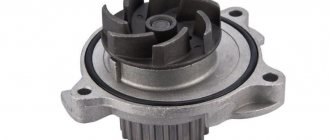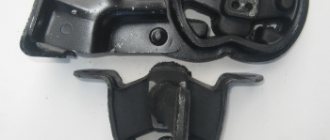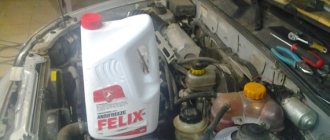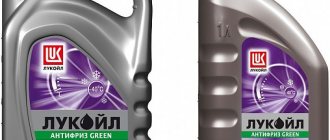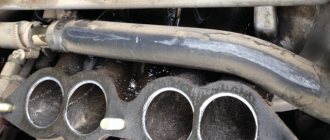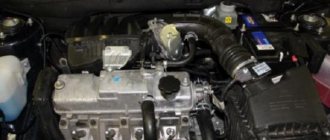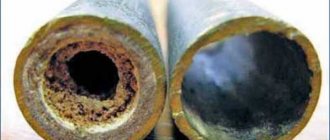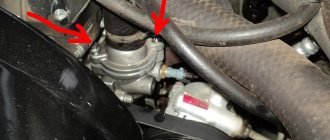How often does antifreeze need to be changed?
Most manuals for car enthusiasts say that antifreeze needs to be changed every 40-45 thousand kilometers. But, in fact, in this matter you need to start from the type of coolant and its classification. For example:
- Class G 11 fluids, intended for cars manufactured before 1996, have a short shelf life of 2-3 years.
- Antifreeze G 12, recommended for cars manufactured from 1996 to 2001, will last longer - 5 years.
- Coolant G 12+, which is used for cars manufactured after 2001, also has a five-year shelf life.
- Liquids G 12++ and G 13 are rarely used in the domestic automotive industry, but they also have a long shelf life.
Healthy! If you mix different types of refrigerants with the same base, then their shelf life is automatically reduced to 2-3 years.
As you can see, a lot depends on the class of the coolant, as well as on the base on which the liquid was made. Ethylene glycol is toxic and takes a long time to decompose, resulting in corrosion on parts of the cooling system. Therefore, it is recommended to change refrigerants of this type more often. Propylene glycol is considered an environmentally friendly product that quickly decomposes, which is why it lasts longer. Therefore, the fluid replacement period can range from 40,000 to 200,000 kilometers.
To determine when it’s time to change the antifreeze, just purchase a special test strip, which you will find at any auto parts store. Another option is to look at the service book of your car; the coolant replacement period must be indicated there.
To replace antifreeze, you need to prepare everything you need: “fresh” liquid, distilled water for rinsing, gloves, a filling funnel and a container for draining. After this, you need to drain the old coolant.
How to drain antifreeze
To make a replacement according to all the rules, it is necessary to drain the antifreeze from the engine, radiator and heating system of the car interior. To do this, you need to drive the car onto a slope, a hole, or use a jack, so that the front of the car is raised. Next, you must wait until the car engine cools down so as not to get burned. After this, perform the following manipulations:
- Unscrew the cap of the expansion tank. In this case, it must be smoothly turned counterclockwise until it stops in order to relieve the residual pressure in the system. You can then remove the cover completely.
- Place a prepared container for draining under the drain plug (on different car models it can be located both on the engine and on the radiator). Then open the drain valve located at the bottom of the radiator and drain the old coolant.
- Close the drain valves and fill the system with clean distilled water. It is important to remember that you cannot pour cold water into a hot engine.
- Tighten all the plugs, but leave the expansion tank open.
- Run the engine for 5-10 minutes to flush the cooling system. In this case, all heating devices in the car must operate at maximum power.
- Drain the water and repeat this step until the drained liquid is clear and clear. For flushing, you can also use specialized flushing compounds.
After this, you can tighten the drain bolt and move on to the next step.
Replacing antifreeze
The process of replacing antifreeze is very simple; our instructions will tell you what and where to unscrew. Follow the prescribed order of operations:
- The car must be placed on as level a surface as possible.
- If there is no horizontal platform, then position the front of the car higher than the rear
- Before starting work, the vehicle should be de-energized; the cost of negligence can be costly.
- Just disconnect the wires from the battery
- As often happens with the “creations” of the Volzhsky Automobile Plant, in order to get to one part (drain plug) we will have to remove another
- If the engine, as already mentioned, is model 2111, in order to calmly drain the antifreeze from the block, you need to unscrew the ignition module and its bracket
- To create an air flow into the cooling system, which will accelerate the drainage of liquid, it is necessary to remove the plug from the expansion tank, shown in the photo
Unscrew the cap from the tank to open air access to the system
- When we have gained access to the drain plug on the engine block, we place an empty container prepared in advance under the engine and then unscrew the plug
- Drain coolant carefully to avoid spilling this toxic chemical around the vehicle.
- After completing the operation, wipe the plug and the hole itself and around it with a clean rag.
We unscrew the drain plug, the container is already under the engine
- The next step is draining the fluid from the radiator
- Move the container under the radiator
- The procedure is similar to draining antifreeze from the block - you need to unscrew the plug and wait for the liquid to drain into the container
- After the liquid has completely drained and the cooling system has emptied, the plugs unscrewed from the radiator and block must be screwed into place
- If we mean a motor with a gasoline injection system, then you will need to loosen the clamp and pull off the antifreeze supply hose from the pipe where it connects to the throttle pipe fitting
Loosen the clamp and remove the antifreeze supply hose on the injector
- If we drained the coolant from the carburetor engine, then unscrew the hose from its connection with the carburetor heating fitting
Remove the pipe marked with a white arrow
- Such actions help avoid the appearance of the famous air locks that prevent fluid from filling the system evenly
- When filling the system with antifreeze, air will exit through these pipes and not get stuck in the system
- After the antifreeze has drained and before tightening the plugs, the cooling system is usually flushed with clean water, after which the plugs are tightened
- Then we fill the system with new coolant
- It is poured through the expansion tank until the level is level with the upper limit of the belt securing the tank
- After filling, screw the expansion tank cap into place.
- The hose that we unscrewed to bleed air is now returned to its place and screwed to the heating fitting
- Then (if you had to remove it) you need to put back the ignition module, which was preventing you from getting to the drain plug
- Then we connect the battery contacts
- Start the engine and warm it up
- Sometimes warming up can help push through any air pockets that have arisen, then the liquid leaves the tank
- When this happens, you need to turn off the engine and add coolant to the required level.
How to pour antifreeze into the cooling system
In order to fill in new antifreeze, the car can be removed from the jack, but before doing this, be sure to check how securely the drain bolt is tightened.
Before pouring antifreeze into the car, make sure that the cooling system is sealed, all elements are intact and functioning properly. Depending on the time of year, the coolant can be diluted with water to varying degrees. After that, follow these steps:
- Remove the cap from the expansion tank filler neck.
- Very slowly, start pouring coolant in a thin stream.
- Different car models require different amounts of antifreeze. In order not to “miss”, pay attention to the translucent wall of the expansion tank, on which the o. She will just tell you how much antifreeze to fill.
Precautions and Tips
When replacing antifreeze, the following recommendations and warnings will help you:
- When deciding how much antifreeze you need, keep in mind that the liquid level in the radiator must reach the lower edge of the neck (if coolant is poured into it).
- When working with antifreeze, be extremely careful and fill it away from children. It is advisable to do everything in the fresh air to inhale as little ethylene glycol vapor as possible.
- If liquid gets into an open area of the body, into the eyes or other mucous membranes, immediately wash the area with clean water.
- Do not allow antifreeze splashes to get on the painted parts of the car body. Especially if you use a liquid with added silicates or based on aggressive ethylene glycol. If coolant gets in, it can corrode the paint, so if this happens, wash the surface with plenty of water.
- The toxic components of the liquid are dangerous to the lives of people and animals, so always close the container with the composition.
- If you use the same antifreeze from the same manufacturer, then flushing the cooling system is not necessary. This procedure is only important when switching to a different type of coolant.
- If you are using a concentrate rather than a ready-made liquid, remember the proportions. In summer, you can add more water to the composition (1:1), since in the heat it will evaporate faster. In winter, you cannot add so much water, as under the influence of low temperatures this will lead to freezing of the liquid. As a result, the expansion tank may burst.
We drain the antifreeze without any residue - the main subtleties of the process
The procedure for draining antifreeze for all cars looks approximately the same. But it’s worth reading the instructions for your model, because in certain cases there are changes to the standard procedure. If after reading the section on changing antifreeze you do not find anything suspicious or unusual, all that remains is to find out where the drain holes are.
These holes are indicated in the diagram in the cooling system section. Next, you need to find these holes and see the type of closure. Often we are talking about a special bolt with a seal that effectively closes the hole and does not allow liquid to leak out. Next, you need to perform the following steps in strict order:
- place a reservoir under the drain holes into which the old liquid will be drained;
- unscrew the cap of the expansion tank, as well as the radiator (this can only be done when the car has cooled down);
- open the stove completely - switch the control to the most efficient operation;
- first unscrew the bolt you found that closes the antifreeze drain hole in the engine;
- Next, you should unscrew the lower radiator cap, draining the liquid from this unit.
Pour new antifreeze into the car's cooling system
When all the work on draining the old fluid and flushing the cooling system is completed, you can begin to replenish the empty reservoirs and fill in new fluid. To do this, just screw in all the lower holes through which the old fluid drained and simply add new antifreeze into the cooling system. But in this process certain difficulties can occur.
Already at the stage of tightening the bolts, which are designed to close the holes for draining antifreeze, many people have difficulties. The machine's owner's manual may indicate how hard the bolts should be tightened. However, this is only a recommendation. You should not tighten the bolt with all your might, but poor tightening will not do any good. The procedure for filling antifreeze is as follows:
- close all holes for draining fluid from the cooling system and wait until the engine cools down;
- leave the expansion tank and the top radiator cap open;
- after filling half the liquid, the radiator cap can be closed and the engine started;
- make sure that the liquid does not leave the expansion tank - constantly add antifreeze;
- when the engine is fully warmed up, you can record the coolant level;
- Leave a few hundred grams of liquid in the trunk just in case.
After a day of use, check the coolant level in the reservoir. It may turn out that the system has taken a little more antifreeze and needs to be added. If you miss the moment, all the liquid will leave the expansion tank, you can create an air lock that will prevent the engine cooling system from working normally.
This is a standard scheme for pouring antifreeze into a car. If your car uses other methods, this will be indicated in the operating instructions for the car. Before carrying out any work on the machine, you should initially obtain more information from official sources. Monitor the level of antifreeze and its quality, because the reliability of your car depends on this.
On Renault cars, replacing antifreeze is performed slightly differently. See the features of the drain in the following video:
Filling with coolant
When all the steps to drain the old fluid have been completed, you can fill in new antifreeze or antifreeze. The brand of coolant must comply with the recommendations of the vehicle manufacturers. Additional additives can have a negative impact and lead to the formation of rust in the cylinder block and radiator.
Antifreeze must be filled to a level between the min and max marks of the expansion tank. It happens that after this air jams may occur. Loosening the pipe clamp will help get rid of their appearance. The coolant is poured in gradually and carefully. From time to time it is necessary to squeeze the radiator pipe while closing the cap. Such actions will also help prevent traffic jams. After the final filling is completed, you need to start the engine and set the stove to maximum operating mode. If no heat is supplied for some time, this means that air pockets remain and the engine may overheat during prolonged operation.
In this article we will talk about how to drain an engine. This procedure is necessary for various reasons. For example, when repairing internal combustion. Even replacing the thermostat requires draining the coolant. But let's look at the main reasons for this procedure in more detail. From the article you will also learn how to fill the system with liquid and bleed it - getting rid of air locks.
Let's sum it up
Any car can be serviced in a garage, but this process should be approached with professional knowledge. Sometimes it's easier to pay a professional a small service fee than to cause irreparable or costly problems to your vehicle. Therefore, think about whether there is a need for independent work, or whether you can entrust a certain process to professionals.
Changing antifreeze does not present any difficulties or problems. The only task will be to follow the manufacturer's recommendations. Also, do not forget about the general maintenance requirements for modern vehicles. Have you ever changed the coolant in your car yourself?
As the car operates, owners sometimes have to deal with the need to drain antifreeze from the cooling system. Although the procedure is not complicated, to perform it correctly and, most importantly, safely, some nuances must be observed. This way, the liquid can be completely drained from the system and possible injuries and damage to car parts can be avoided.
You also need to fill it correctly
Now that you know how to drain antifreeze from a VAZ-2110, you can talk about how to properly fill in fresh refrigerant. This process is much simpler than the previous one, but there are some nuances here.
The main task facing a car owner who is pouring coolant into the system is to prevent air locks from occurring in it. No, they are not dangerous for the engine, but they are extremely undesirable, especially in winter, when the “stove” operation is necessary. Plugs create obstacles to the normal circulation of the refrigerant, and in addition, reduce its volume in the system. So it turns out that we filled in 6-7 liters, but the “stove” does not heat as it should. And the troubleshooting begins.
But when filling in antifreeze, all you need to do is disconnect the hose from the throttle assembly and fill until the refrigerant flows out of it. After this, we put the hose on the fitting and continue to fill the liquid to the level. When it is reached, without closing the expansion tank cap, we start the engine, wait until it warms up to operating temperature, and “pump” the hoses going to the cooling radiator, periodically squeezing them with our hands. Air, if there is any, will definitely come out. All you have to do is add liquid to the level.
Why do you need to drain the coolant?
The cooling system of modern cars uses antifreeze as a heat transfer fluid. At first glance, it may seem that this fluid does not need to be replaced, because the system is closed and nothing gets into it from the outside. The main components of antifreeze are ethylene glycol and water, but no less important are additives that prevent corrosion of cooling system elements, lubricate and protect them. As the vehicle is used, the additives lose their properties, which leads to the formation of corrosion with subsequent disruption of the performance of parts. As a result, particles of metal and other materials settle and clog the radiator and other system components. This leads to deterioration in engine cooling and, as a result, to overheating.
How to prepare a car for draining coolant
To drain the antifreeze, you need to perform some preparatory measures. Since the substance in question is toxic, it should not be dumped on the ground. For these purposes, resealable containers are used, which are disposed of in accordance with environmental standards. Preparing the car consists of placing it on a flat horizontal surface to more effectively drain fluid from all pipes and components. On almost all cars, the coolant is drained through a special hole, which is sometimes located in the lower part of the radiator or on the pipes.
If there is no hole, drainage is carried out through the removed radiator pipe.
An important point is compliance with safety precautions: draining antifreeze from a hot engine is strictly prohibited. Due to the high heating temperature of antifreeze, there is a high probability of getting burns during operation. In addition, as a result of heating, the liquid in the system is under pressure and when any lid is opened, it will be released. Therefore, you first need to wait until the engine cools down to ambient temperature and only then unscrew the cap of the expansion tank and radiator.
Draining procedure
If you don’t want to overpay for a car service center, but don’t have practical experience in how to drain coolant from an engine, then you can check out the master class on replacing antifreeze using the example of a VAZ-2114 car. First of all, it is necessary to carry out certain preparatory manipulations, which include:
- Placing the car on the platform, since ideally it should be in a horizontal position.
- Waiting for a certain time necessary so that the motor and the liquid in it can cool down and not cause burns to the novice master. Even opening the cap of the expansion tank or any other unit can trigger the release of scalding antifreeze steam with all the ensuing consequences.
- Study of the system design and location of antifreeze drain points.
The fact is that not every inexperienced technician will be able to immediately determine where the coolant drain plug is located in his car. The designs of this system may vary depending on the make of the vehicle. Most often it is located at the very bottom of the radiator or in the pipes extending from it.
The presence of a special drain plug, which is not provided in all designs, is of great importance for the process of draining used technical fluid. And if it is not there, then the antifreeze is released from the main engine block by disconnecting the lowest pipe from the radiator. This is how the antifreeze is drained from the cooling system, after which it must be thoroughly rinsed with distilled water to prevent the development of possible problems due to potential incompatibility of technical fluids from different manufacturers.
How to drain antifreeze
Draining coolant from the system can be divided into several stages, each of which has its own characteristics.
Through the radiator
After preparing everything you need, follow these steps:
- Remove the motor protection by unscrewing the corresponding fasteners.
Video: draining antifreeze from the radiator
From the engine block
Since draining antifreeze from the engine block is a continuation of the procedure under consideration, we move the container under the drain hole on the engine and perform the following actions:
- We remove the elements that prevent free access to the drain plug. Depending on the car brand, these elements may vary.
- Carefully unscrew the plug.
From the expansion tank
Over time, sediment collects in the expansion tank. Therefore, when replacing the coolant, draining the substance from this container and rinsing it will not be superfluous. The essence of the procedure is to disconnect the pipe going to the radiator, followed by draining the liquid into a suitable container.
Another option is possible: the coolant can be drained through the neck using a thin tube, for example, a medical dropper.
Video: how to drain antifreeze from the expansion tank
Using jacks
The actions when using jacks largely repeat the standard procedure for draining antifreeze. After installing the container and unscrewing the plugs, the rear wheels are raised as high as possible. After 20 minutes, the car is lowered and only the left wheel is raised. After the same period of time, the car is lowered and the right wheel is raised. After such actions, a certain amount of liquid will pour out of the system each time.
A similar procedure can be used for repairs in the field by placing the machine on an incline.
Using a compressor
An air compressor can also be used when draining antifreeze. It is connected to the cooling system and air is supplied, gradually removing coolant. Although this option can be considered, but only as a last resort, since depending on the power of the device, too high a pressure may be created in the system, which will damage the plastic elements. In addition, not every car enthusiast will have a compressor of the required performance at hand.
How to drain antifreeze from VAZ 2110, 2111, 2112
1). We place the car on a horizontal platform.
2). Disconnect the “-” terminal from the battery.
3). We remove the ignition module, as it may interfere with unscrewing the cylinder block drain plug.
4). Unscrew the cap of the expansion tank (open the tank only when the engine is cold).
5). Using a wrench or spanner, unscrew the plug on the engine cylinder block, from where the waste fluid will flow.
6). After all the liquid from the block has been drained, we wipe the car engine with some kind of unnecessary rag, namely, we wipe the places where the liquid got in during draining.
7). We wrap this plug and go to the plug located on the radiator and in the same way completely unscrew the plug and pour all the liquid remaining in the radiator into a container.
 . We wrap all the unscrewed plugs back into place.
. We wrap all the unscrewed plugs back into place.
How to drain antifreeze from Lada Kalina?
1). We drive the car into the inspection hole so that it stands level. Ideally, of course, the front of the car should be slightly higher than the rear.
2). Remove the “-” terminal from the battery.
3). Unscrew the expansion tank cap (only with a cold engine).
4). We place some kind of container under the drain plug of the cylinder block and unscrew this plug using a spanner. We drain all the liquid from the block into the previously prepared container.
5). We perform exactly the same operation with the radiator. But here, in order to unscrew the plug, it is not at all necessary to use a key, since this can be done with your hands.
6). We wrap both plugs.
Video
How to drain antifreeze from a Chevrolet Niva?
1). We place the car on the inspection hole and fix it.
2). We unscrew the cap on the expansion tank (only on a car with a cold engine, otherwise you can get burned by the steam).
3). Unscrew the plug on the drain hole and drain all the liquid. As soon as all the used antifreeze has drained, screw the plug into place.
4). To eliminate the possibility of plugs forming in the air system, disconnect the hose from the throttle assembly fitting. To do this, use a screwdriver or pliers to loosen the fastening on the clamp and move it back. Then disconnect the hose from the throttle body fitting.
Video
How to drain antifreeze from a Lada Granta?
1). We drive the car into the inspection hole and wait until the engine cools down.
2). Remove the cap from the expansion tank.
3). Place an empty container under the engine and remove the drain plug on the cylinder block. For VAZ-11183, VAZ-21116 and VAZ-11186 engines, to access the drain plug, you may have to remove the ignition coil along with the bracket.
4). We wait until the antifreeze completely leaks out.
5). Place a container under the engine radiator and remove the drain plug on the radiator.
6). We wait until the liquid completely drains from the cooling system.
7). We wrap the drain plug on the radiator.
 . We tighten the plug on the cylinder block.
. We tighten the plug on the cylinder block.
How to drain antifreeze on Renault Logan?
1). We place the car on a level surface, ensuring full access to all elements in the front of the car.
2). We dismantle the engine crankcase protection.
3). We prepare a pre-prepared container near the radiator of the cooling system.
4). Loosen and unscrew the clamp at the pipe connected to the radiator.
5). We unscrew the valve located on the hose of the outlet fitting, which is designed to release air from the system.
6). We wait until all the antifreeze has drained into the container. Please note that the volume of container used for these purposes must be more than 6 liters.
7). After all the old antifreeze has been removed, we mount the pipe back onto the radiator and secure it with a new clamp.
How to drain antifreeze from a Hyundai Accent?
1). We place the car on an inspection ditch.
2). We remove the expansion tank of the engine cooling system by disconnecting the radiator steam hose from it. We drain the liquid from it and install it in place.
3). Remove the engine splash guard.
4). Remove the radiator filler cap by turning it 90 degrees counterclockwise.
5). We place a container under the drain hole of the radiator of the cooling system. We unscrew the drain plug and drain the coolant from the radiator.
6). Remove the air filter.
7). We squeeze the antennae of the clamp, slide it along the hose (in the photo, the radiator outlet and inlet hoses have been removed for clarity) and disconnect the hose going to the water pump from the thermostat housing branch pipe, and drain the remaining coolant from it into a previously prepared container.
 . Connect the hose to the pipe and tighten the radiator drain plug.
. Connect the hose to the pipe and tighten the radiator drain plug.
How to drain antifreeze from Ford Mondeo?
1). Turn off the car engine and let the engine cool.
2). For safety reasons, disconnect the “-” terminal from the battery.
3). We relieve excess pressure in the cooling system, which can be done by unscrewing the cap of the expansion tank. Just remember, this can only be done after the engine has cooled down.
4). Next, we drain the antifreeze; therefore, place a previously prepared empty container under the drain hole.
5). We tighten the drain plug.
Video

